Table of Contents
surfaces
Configuration options
Areas can be documented using two different methods: after Gauss-Elling and based on Standard geometries (Triangles, trapezoids, etc.), whereby the options triangles according to Heron and suppress squares can be activated (see chapter Documentation methods).
Six areas can be configured for the visible documentation in the drawing: Point symbols, Number standard geometries, bending, Shapes, triangles and Squares. The specifications from the Configuration adopted.
If the scope of area objects should also be documented, you can deactivate the option Suppress route documentation of the scope at the same time the scope can be created as route documentation.
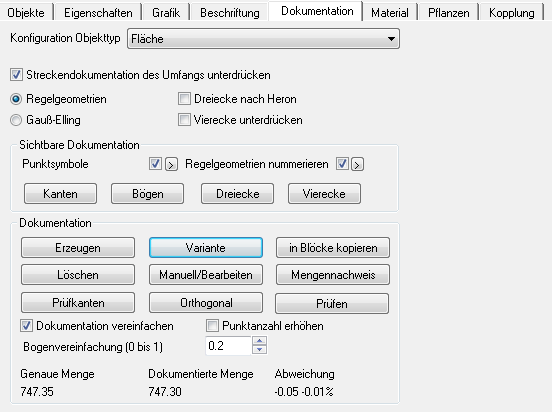
In addition, the documentation can be simplified (see Documentation options > Simplify documentation) or increase the number of points (see Documentation options > Increase the number of points). The discrepancy between the simplified documentation and the exact amount of the selected drawing object is in the range Documentation displayed.
In order to improve the clarity in the drawing, the documentation of the areas is based on the preset Layer Documentations_Flaechen stored (for 3D surfaces: Documentations_Flaechen_3D). This can be changed by selecting an existing layer in the drawing or by entering a new name using the keyboard. This layer is then used by DATAflor CAD created.
Options for Point representation and Shapes correspond to those for routes (see Courses > Configuration options).
Number standard geometries
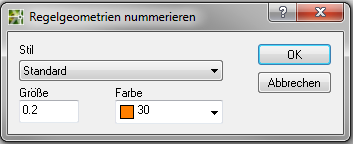
The font style and size as well as the color can be specified for the numbering of the standard geometries. Also note the extended options via the Configuration.
Triangles and squares


With triangles and squares, the Line type and the Color can be set. Furthermore, the graphic representation of the Heights suppress.
bending
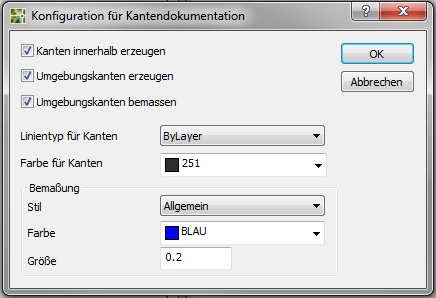
The option Dimension surrounding edges is essentially for documentation about Test edges or orthogonal necessary. This option can only be activated if the option Generate surrounding edge is activated.
In the middle of the bending can be the line type, color and area Dimensioning the font style, color and size can be set.
Documentation methods
Two different documentation options are available for surfaces, whereby when breaking down into standard geometries (triangles, trapezoids, etc.), the triangles can optionally also be documented according to Heron. The different documentation methods not only affect the writing of the quantity statements, but also influence the drawing layout, which can be individually adapted.
Method 1: standard geometries
Areas are broken down into partial areas and listed individually in drawings and quantities. Different formulas are used depending on how the breakdown into standard geometries is carried out (see Explanation of calculation methods > Calculation formulas REB 23.003).
Triangles according to Heron: Optionally, the documentation of the triangles according to Heron can be activated for the breakdown into standard geometries. Formula 01 is used for triangles instead of Formula 03. Formula 01 derives the area using the base and the height, whereas formula 03 determines the areas using the base sides. Heron is always activated for 3D surfaces, since determining the surface with the height in 3D space can be problematic. The height gives no information about the position of the triangle in 3D space. |
Suppress squares: Optionally, the documentation can be generated without rectangles when breaking it down into standard geometries.
Area decomposition with standard geometries

Area decomposition with regular geometries and triangles according to Heron

REB formulas used:
- 99 - Explanation of the object
- 01 - triangle (above base height)
- 04 - rectangle
- 05 - trapezoid
- 07 - district sector
- 09 - parabolic segment
- optional: 03 - standard geometry calculation with triangles according to Heron
Method 2: Gauss-Elling (not for 3D surfaces)
Values for formula 22 (irregular polygon from coordinates) are entered in the quantity statement (see Explanation of calculation methods > Calculation formulas REB 23.003). Will the Reference point changed, a different origin is selected for the calculation in the documentation (see Instructions for use > Documentation according to Gauß-Elling in the high coordinate range (Gauß-Krüger)).
This documentation method cannot be used for 3D surfaces, since according to REB specifications only 2 coordinates are possible, so the Z value cannot be taken into account.

REB formulas used:
- 99 - Explanation of the object
- 22 - Irregular polygon made of coordinates
- optional: 07 - additional circle sector calculation for circles
Automatic documentation
The procedure for creating documentation for areas corresponds to that for routes (see Courses > Automatic documentation). The only special feature is the creation of documentation variants for the breakdown into standard geometries.
In the case of surfaces, there are always several options for breaking them down into standard geometries (triangles, trapezoids, etc.). If another variant is to be created, the object must be marked in the mass tree.
With [Variant] in the tab Documentation the area is now broken down into other
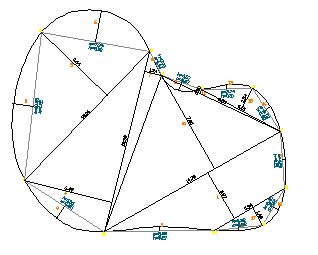
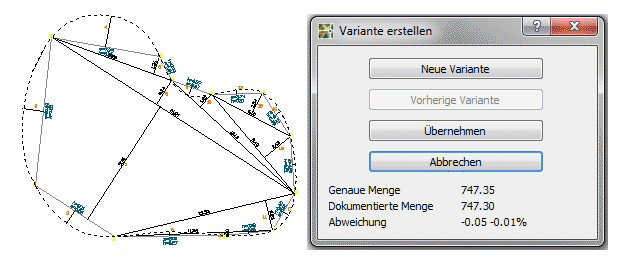
An [New variant] can be selected until the required documentation is displayed.
In addition to normal 2D and 3D surfaces, a triangulation be documented. For this, the triangulation must be recorded as a 3D object. The documentation of triangulations cannot be created or edited manually.
If documentation is created for an area, the route documentation is also created at the same time. This is necessary because there is a coupling to DATAflor BUSINESS the CAD objects and object properties can be transferred to positions. Exactly which property is used depends on the position in DATAflor BUSINESS dependent. The creation of route documentation for areas can, however, be suppressed (see Configuration options).
The manual creation of documentation or the editing of automatically created documentation is described under Documentation manual ⁄ edit explained.
Automatic documentation via test edges
The function [Test edges] offers the possibility of defining edges within an area to which the documentation is aligned. After defining the edges, the documentation is created automatically.
Application
- In the mass tree, mark the area whose content is to be documented. Switch to the tab Documentation and choose the documentation method.
- In the area Documentation choose [Test edges] .
- Define the edge using two points.
To define the edge, select only points that are on the boundary. Use an object snap to do this.
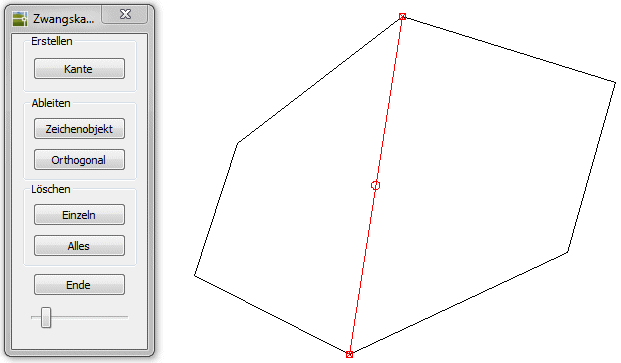
- With the function [Drawing object] in the field of Derive you can use an existing straight line that has two intersections with the recorded area as a test edge.
- With the option [Individually] in area Delete can you single Test edges delete, with the function [Everything] delete You all edges.
- Close your editing with the function [The End] .
- The documentation is created in the drawing.
| without test edge | with test edge |
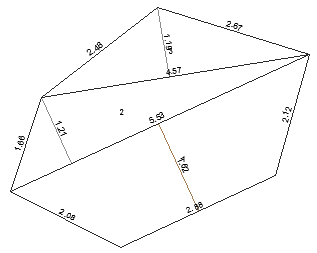 | 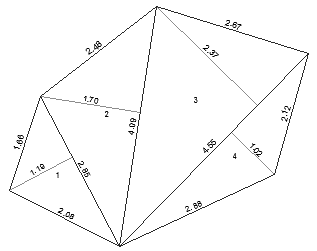 |
The values of the outer edges should be displayed for complete documentation. To do this, go to the tab Documentation in the field of Visible documentation on the button [Edge]. Activate in the dialog Configuration for edge documentation the options Generate surrounding edges and Dimension surrounding edges.
Automatic documentation via orthogonal
The function [orthogonal] offers the possibility of defining edges within an area to which the documentation is aligned. For this purpose, vertical test edges are automatically created along a selected ordinate, on the basis of which the documentation is created.
Application
- In the mass tree, mark the area whose content is to be documented. Switch to the tab Documentation and choose the documentation method.
- In the area Documentation choose [orthogonal] .
- Define the ordinate using two points. As soon as the second point has been defined, the edges are created.
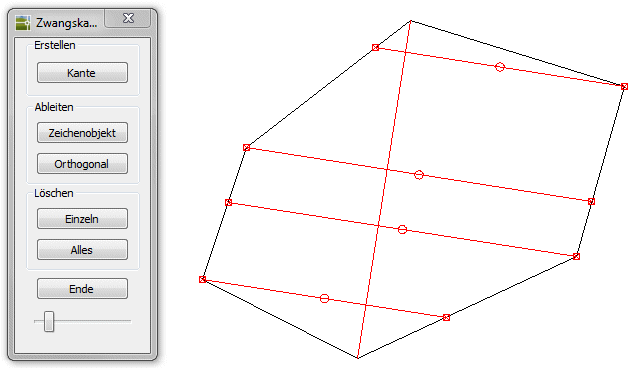
- With the option Delete > [Single] you can use individual edges delete, with the function Delete > [All] delete You all edges.
- Close your editing with the function [The End] .
- The documentation is created in the drawing.
| without orthogonal | with orthogonal |
 | 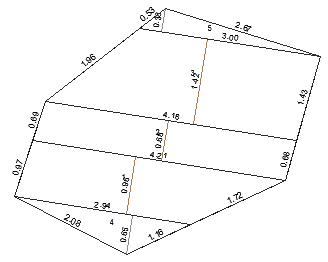 |
The values of the outer edges should be displayed for complete documentation. To do this, go to the tab Documentation on the button [Edge]. Activate in the dialog Configuration for edge documentation the options Generate surrounding edges and Dimension surrounding edges.
